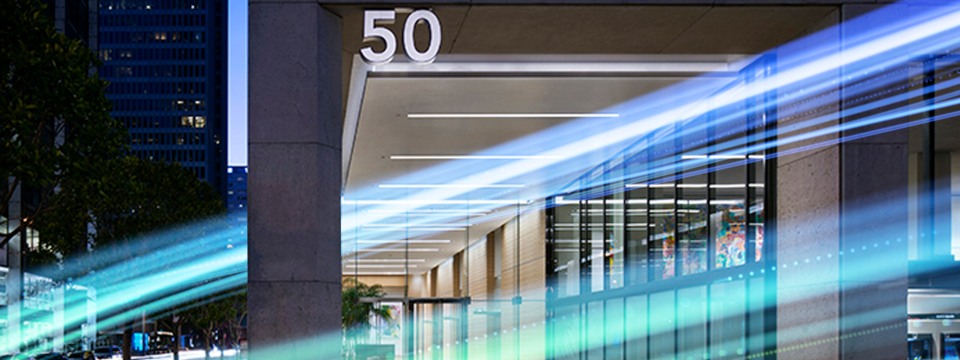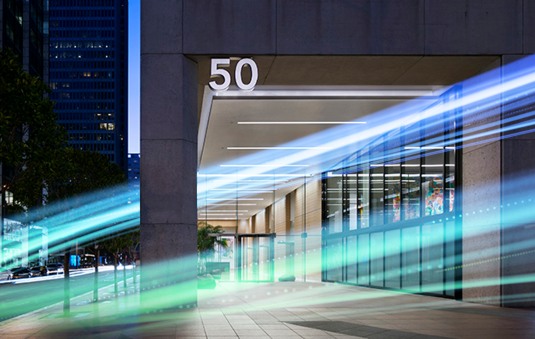
SAN FRANCISCO, CA
Challenge
Although the two 45-year old Trane® CenTraVac® chillers, serving the needs of the 50 California Street office building, were still in good working condition, the equipment was reaching the end of its useful life. Building owner, Shorenstein Properties, knew it was time to replace the equipment. They also knew that, with the chillers located on the difficult-to-access 37th floor of the “trolley street” high rise, it wouldn’t be easy. A replacement project would be expensive, needing street closures during weekend hours, permits and extensive rigging to gain access to the chillers. In addition, building engineers were concerned with the efficiency of the aging equipment, and sought to upgrade the chillers with energy saving technologies that would also improve tenant comfort in the building that was sometimes running warm.
“The chillers were approaching obsolescence, the factory was no longer making parts, and we needed to improve the building’s energy efficiency,” said Dennis Cornish, chief engineer, Shorenstein Properties. “We knew the high cost of installing replacement chillers. What else could be done?”
Solution
Having had an equipment and service relationship with Trane that began when the building was built in 1972, Shorenstein Properties discussed their challenges with their account team. After confirming the viability of using a process similar to one they previously used to replace the building’s cooling towers, the sales office suggested implementing Trane TriStar, a chiller rebuilding option.
Evaluating chiller rebuild vs chiller replacement
TriStar is a process of rebuilding a chiller, using the existing shells, and replacing all major components. Trane provided a cost comparison of installing a replacement chiller vs a TriStar, taking into account installation costs, energy performance of new chillers, the reduced load profile of the building, and energy savings resulting from the addition of new technologies and energy saving strategies. Shorenstein Properties hired a third-party consulting engineer to evaluate the Trane solution. The consultant compared scenarios and analyzed more than a dozen criteria, before validating the proposed budget. “We looked at Trane’s numbers, the kW per ton, our peak demand at start-up, and other data,” said Cornish. “TriStar was custom engineered and designed, and also factory supported. It all made sense.”
Creating a design to meet capacity and efficiency requirements
Trane moved forward with a custom design that would meet the needs of the building. A reduced load at the building, due to the implementation of LED lighting and other efficiency measures over the years, allowed the de-rating of the two chillers from the existing 1000-tons to two 800-ton Trane® CenTraVac® chillers. The Trane CenTraVac chillers deliver the industry’s highest full- and part-load efficiency, and provide a low-speed, direct-drive design for quiet, vibration-free operation, low leak rates and improved efficiency.
Reducing installation costs with piece-by-piece conversion
Trane procured the required parts to rebuild the compressors, and began to disassemble the old chillers. So as not to disrupt the business operations, one chiller was taken down at a time. The existing tubes, evaporators and condensers were cleaned, while the compressors and major components were torn out, plasma cut to fit in the freight elevator, taken to the loading dock and hauled away. Parts were taken up in the elevator, where the two chillers were rebuilt, with new compressors and key components, to the exact specifications for the required load.
Implementing energy-saving technologies
Once the chillers were in place, Trane Adaptive Frequency Drives and Tracer AdaptiView™ chiller control panels were installed. The Adaptive Frequency Drives reduce power consumption by adapting the compressor motor speed and inlet guide vanes to the chiller operating temperatures, allow better start-up and shut-down, and enable more efficient part-load operation. Building operators use Tracer AdaptiView to view and control chiller operations and gain insight into the operating patterns, energy use and system performance. To further improve efficiency, the chillers were set to run with condenser relief, lowering the condenser water temperature to 60 degrees. “There were no variable frequency drives back when we installed the original chillers,” said Cornish. “The TriStar rebuild gave us the opportunity to include VFDs to improve our energy efficiency.”
Results
To overcome the challenges of a difficult equipment replacement, Shorenstein worked with Trane to implement a TriStar rebuild of the two aging chillers serving its 50 California Street property. The cost of the TriStar was approximately half of what it would have cost to complete an expensive chiller replacement requiring street closures, permits and extensive rigging. The TriStar also enabled the property owner to increase energy efficiency with the upgrade to newer technologies, use of a low condenser water temperature, and the addition of Trane Adaptive Frequency Drives. Chiller energy use has decreased from approximately 2000 kW per ton to 1700 kW per ton, even during the hot summer months, with peak energy demand decreasing from approximately 2300 kWh per ton to 1800 kWh per ton, for an energy cost savings of approximately $18,000 a month. “We are exceeding the estimated energy savings, have improved operations, and the chillers are quiet,” said Cornish. “Most importantly, we’ve resolved the issue of chiller obsolescence.”
ABOUT 50 CALIFORNIA ST.
A 37-story office building, 50 California Street is owned by Shorenstein Properties, one of the country’s oldest and most respected real estate firms. The LEED® Platinum certified building houses a variety of diverse tenants. Located in the heart of San Francisco’s Central Business District, just steps away from all forms of public transportation, including the historic California Street Cable Car, the flagship property is as convenient as it is prestigious. Fine restaurants, internationally renowned hotels, spacious parks and a wide variety of retail shops are all within easy walking distance. The building features vertical precast concrete columns with opaque spandrel and clear glass panels, and a bright, airy, contemporary lobby featuring frameless glass walls and the finest finishes of Jura limestone, olive ash wood paneling and millwork.
Project Highlights
Challenge
• Chillers nearing obsolescence
• Difficult high-rise installation
• Increase efficiency
• Improve tenant comfort
Solution
• TriStar
• Adaptive Frequency drives
• Tracer AdaptiView™ control panels
Results
• Eliminated obsolescence issue
• 50 percent savings vs chiller replacement
• Reduced energy use and peak demand
• $18,000/mo energy cost savings
• Improved operation and indoor comfort

































































































